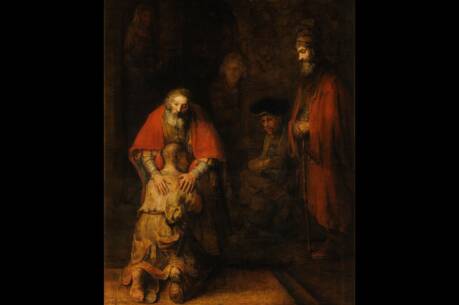In the Assembly of the People
The tragedy of Philip Nolan, the subject of The Man Without a Country, was not merely that he was forbidden ever again to set foot on U.S. soil or even to hear spoken the name of his country of origin. It was his fate, chosen by the man himself in a moment of anger, to belong no longer to any nation. He was a man without a community. He experienced what we all eventually realize, that as independent as we like to think we are, as human beings we desperately need to belong. Today’s readings form a kind of triptych, a three-part illustration of what it means to belong to a post-resurrection community.
The first panel (Acts) is quite realistic in its presentation. It shows Paul, shortly after his conversion, arriving in Jerusalem with Barnabas. While Paul may have been eager to join the group of disciples, they were understandably suspicious of him. After all, not too long ago he had diligently searched for them in order to hand them over to the authorities intent on stamping out this new movement. But on the word of Barnabas, they accepted him into their number and eventually even protected him when his life was in jeopardy.
This is a remarkable community. They not only forgave him, but they actually embraced their own persecutor. How many communities today exhibit such a sense of reconciliation? How many communities open their hearts and their doors to people whose sins have become public? Jesus did not hold Paul’s sin against him; so, following this example, neither did the disciples. This accepting attitude is evidence of the presence of the risen Lord in the post-resurrection community.
The exhortation found in the second panel (the Letter of John) alerts us to the twofold bond that unites all members of this community. We are told to “believe in the name of God’s Son, Jesus Christ, and to love one another.” This love of others is not based on personal preference, any more than the acceptance of Paul was based on it. Rather, everything is based on faith in the risen Lord. We first believe in the risen Lord, and then this faith manifests itself in love of others.
The love to which John calls us is neither easy nor romantic. It is not love merely “in word or speech, but in deed and truth.” It manifests itself in ways that may call for a kind of heroism— accepting back those who earlier had turned away, being open to those who live their lives in ways that we consider unorthodox, welcoming the stranger or those who are in any way threatened. Such love, which is inspired by the Spirit, is evidence of the presence of the risen Lord in the post-resurrection community.
Jesus’ declaration to his disciples (John’s Gospel) constitutes the center panel, and is really the focal point of the triptych. While the first two panels emphasize the bond that unites members of the community to one another, this centerpiece highlights the union of the members with Jesus himself. The metaphor of vine and branches, a metaphor that under the circumstances is quite bold, vividly characterizes the intimate nature of the relationship between Jesus and his followers.
A vine is made up of its branches, and the life of the vine is the life of the branches. Jesus lives in his branches, and his branches live in his life. The vine bears fruit through its branches, and the branches bear the fruit of the vine. As important as the branches are, the vine is not totally dependent on any one branch or group of branches. Therefore, it can endure pruning without withering and dying. But there is no vine if there are no branches at all. In such a case, there is only a trunk, and that is not the metaphor that Jesus uses here.
In the face of possible pruning, Jesus declares, “Remain in me, as I remain in you.” Don’t separate yourself from me; don’t try to make it on your own; don’t renounce your membership in me. You are not without a country; you are not without a community; you are not without a source of life.
If the life of Jesus flows through our “veins,” we will “bear much fruit.” We will indeed shine forth in our world as a community called together and enlivened by the power of the resurrection. We will be a reconciling community, open to others and able to show the world that reconciliation with our enemies is possible. We will be a community bound to one another by love and able to bring genuine love to a world eaten away by hatred. We ourselves will be the evidence of the presence of the risen Lord in the post-resurrection community.
This article also appeared in print, under the headline “In the Assembly of the People,” in the May 12, 2003, issue.







